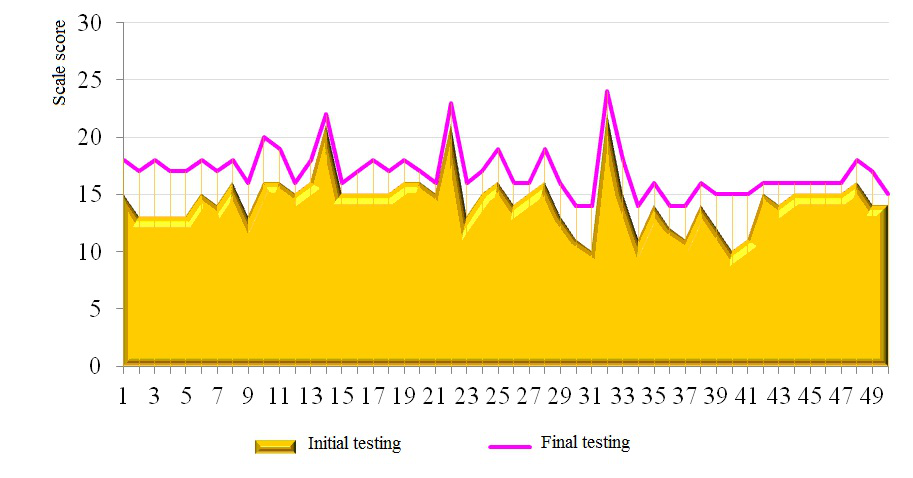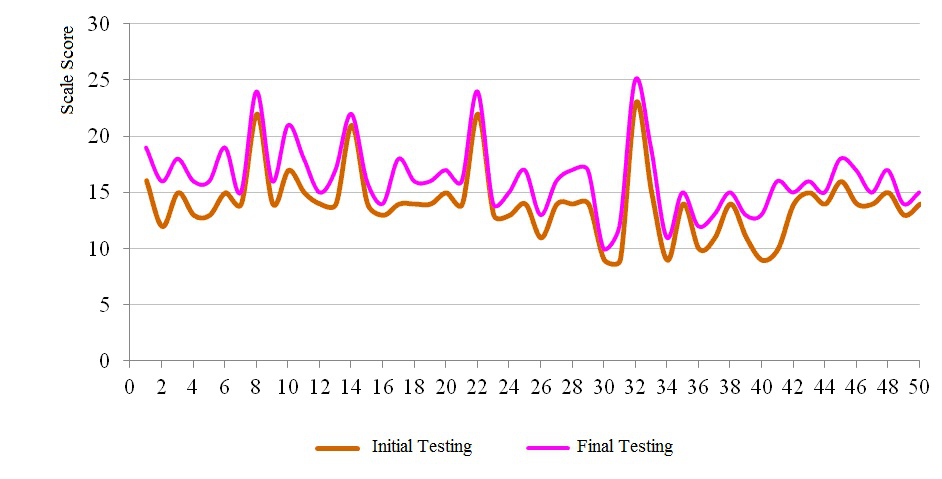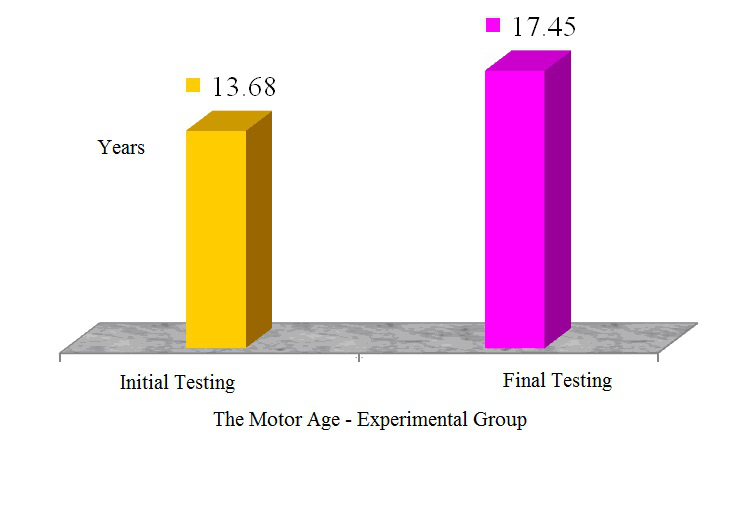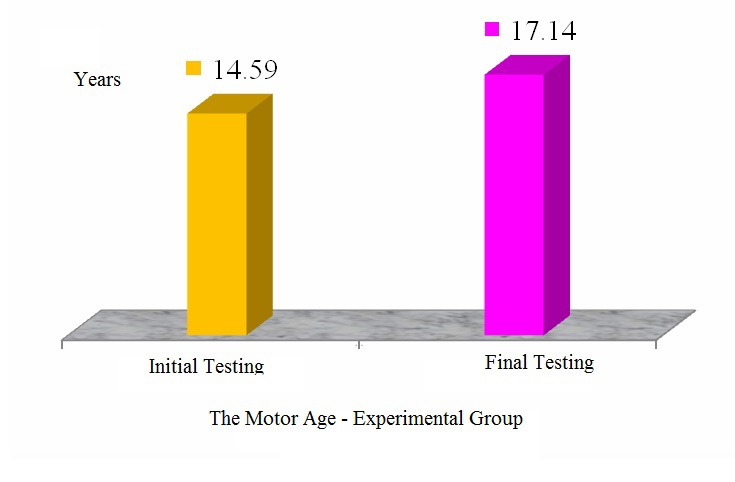An Experimental Study Regarding the Influences of Sport Disciplines on the Psychomotricity of the Students from the University of Bucharest
Abstract
Being a result of the connection between the psychic and motor factors, psychomotricity represents a fundamental psycho-behavioural component with an extremely high influence on the ontogenetic development of the individual. The present work wants to highlight the influence of sports disciplines (aerobics, table tennis) on some aspects of the psychomotricity of students from the University of Bucharest, materialized through statistically significant differences at the level of running speed and agility and strength tests within the Bruininks-Oseretsky Test of Motor Proficiency, Second Edition (BOT-2). The experimental method: We used, for the first time in Romania in young students, the improved version of Bruininks-Oseretsky Test (BOT-2), which aims at evaluating a wide range of motor skills in subjects between the ages of 4 and 21. For this study, from the total of eight subtests specific to motor areas, we opted for the running speed and agility and strength subtests. It is known that strength, speed and agility are important components involved in motor performance of daily activities, not only in sports activities. Based on the information provided by the Bruininks-Oseretsky Test (BOT-2), we could do an analysis of the relationship between motor proficiency age and chronological age in young students. Methods used: Statistical and mathematical method, graphical method. Psychomotricity is of major importance for the physical education field and not only, and it offers the youth, through a systematic and correct approach to its inner components, a favourable climate for an efficient adjustment to the requirements of the social and academic environments.
Keywords: Physical education, psychomotricity, running speed, strength, students
Introduction
In the current socio-economic context, when free time dedicated to recreational sports activities is
more and more an inaccessible “luxury” even for young students, the sports disciplines practiced in an
institutionalized framework remain the only way which responds to their need for movement, desire to
improve their motor capacity, to optimize their health etc.
Modern pedagogy, in collaboration with other sciences, is increasingly concerned with
implementing efficient teaching technologies to put the student in the position to actively participate in
building his/her own personality within a formative system of education.
In line with these concerns, it is necessary and natural that the efforts of all staff of specialists to
upgrade physical education are focused on continuing research to provide practical solutions and
innovating ideas. At all levels of education, the main objective of physical education and its main
purpose are to cultivate the love for movement, forming the habit of the systematic practice of physical
exercise, of organizing and spending one’s free time usefully and creatively.
Motricity, with all its components, enriches the biological and psychological inheritance of the
young people. Physical exercise, as its main instrument, is the biological stimulus which provides
harmonious morphological and functional development, the balanced education of motor qualities, and
also the acquiring of motor skills and abilities (basic, applicative, specific to sports branches).
Continuing motor education at this stage leads to the following finalities (Dragnea & Bota, 1999:
143):
- superior sensory-perceptual capacities;
- improved basic motor schemes;
- rich baggage of motor skills and abilities;
- increased expressive, aesthetic capacity of gesture communication;
- ability to practice exercise independently;
- superior socialization.
Materials and methods
In this study, we intended to verify the following:The specific operational means of the
chosen sport disciplines, applied within the physical education lessons according to appropriate criteria
and the physiological, psycho-pedagogical requirements specific to youth, can lead to achieve higher
indices of expression of motor qualities - strength and speed, in their various forms of manifestation,
and also to exert a positive influence on the motor age.
Subjects
For developing the experiment, the sample was composed of 50 UB (University of Bucharest)
students, freshmen, aged 18-20 years, enrolled in various faculties of the University of Bucharest, who
have opted for the sport disciplines “aerobics” (25 students) and “table tennis” (25 students).
Both the initial and final testing of the experimental group and the effective implementation of
training programs were carried out in the Pitar Moş gym, which ensured optimal conditions for our
approach.
The development of the experiment, data collection and conducting the training programs were
carried out as follows:
The experimental group:
The initial testing took place from 7 to 11 October 2013 and was aimed at knowing the initial values
of the research parameters - the dependent variable. The final testing took place from 12 to 16 May
2014 in order to highlight changes in the research parameters after following the programs of sports
disciplines aerobics and table tennis.
The testing carried out with the experimental group was conducted in the gym of the Faculty of
Foreign Languages, which provided optimal conditions for this. The weeks during which the initial and
final tests took place were not included in the training program. Intervention on the experimental group
was throughout the 22 weeks of application of the independent variable - namely the specific contents
of the sport disciplines aerobics and table tennis. We mention that the tests were conducted by Lecturer
Gozu Bogdan, PhD, the owner of Bruininks-Oseretsky Test of Motor Proficiency, Second Edition
(BOT2), and also the owner of the license for the test application and the interpretation of the results.
Test Battery
For the research, we used, for the first time in Romania in young students, the improved version of
Bruininks-Oseretsky Test (BOT-2). Bruininks-Oseretsky Test of Motor Proficiency, Second Edition
(BOT-2), is a series of tests administered individually, with very precise and well-targeted objectives,
which aim to assess a wide range of motor skills in subjects (Flegel & Kolobe, 2005). This test was
designed to be used, among others, by kinesiotherapists (Tan, Parker, & Larkin, 2001), psychologists,
sports teachers, coaches, and it seeks to offer them an efficient instrument for measuring fine and gross
motor skills (Crowe, 1989; Ulrich, 1985). BOT-2 assesses abilities from four different motor areas
(Bruininks et al., 1990; Faught et al., 2002; Smits-Engelsman, Niemeijer, & Van Galen, 2001).
For this research, from the total of eight subtests specific to motor areas, we have opted for the
running speed and agility and strength subtests, which involve the following items:
Subtest 6: Running speed and agility Subtest 8: Strength
Content: Content:
Item 1: Shuttle run; Item 1: Standing Long Jump
Item 2: Stepping Sideways over a Balance Beam Item 2: Push-ups
Item 3: One-Legged Stationary Hop Item 3: Sit-ups
Item 4: One-Legged Side Hop Item 4: Wall Sit
Item 5: Two-Legged Side Hop Item 5: V-up
It is known that strength, speed and agility are important components involved in motor
performance of daily activities, not only in sports activities.
A correct approach of all psychomotor components, which would take into account the age, as well
as the established instruction objectives, will reflect on the youth’s behaviour through the gain of
important acquisitions, which will represent the premises for a good effort capacity, an optimal health
and therefore an improved physical and mental wellbeing.
Bruininks-Oseretsky Test of Motor Proficiency, Second Edition (BOT-2) provides the evaluator a
number of derived scores intended to facilitate the optimal interpretation of the results and their
effective communication to the persons directly concerned. Terms such as,
, and are used to describe the performance achieved by the subject in the subtests, while standard score, confidence interval, percentile rank and descriptive
are indicators of performances achieved at the level of motor component (areas) also when
using the short version of the test battery (Bruininks & Bruininks, 2005).
Further, we will make a brief description of each type of derived score for a better understanding of
their significance within the analysis.
Theis used to describe the performance level achieved by the subject in each subtest
and represents the positioning of the obtained score in relation to the average scores of other subjects of the same age, taking into account the standard deviation of scores characteristic for a representative
sample.
The(category description), along with other types of derived scores previously
presented, is another indicator through which the assessment results are communicated in an efficient
way. This term is a transposition into words of the approximate distance between the interval score and the average age of the group. Table 1 presents the five descriptive categories corresponding to the scale
scores, standard scores, percentile rank and standard deviations from the mean.
Before the actual presentation of the research results, it should be noted that both processing and
interpretation of raw scores obtained by the examined subjects (subsequently converted into derived
scores)were performed using the specific software of Bruininks-Oseretsky Battery, Second Edition
(BOT-2 ASSISTTM, Scoring and Reporting System). Statistical processing of the research results was
accomplished using the following software:
- BOT-2 ASSISTTM, Scoring and Reporting System: software belonging to the Bruininks-Oseretsky Test, Second Edition;
- MINITAB 15.1 of MINITAB Inc.: software used to process statistical data inside a phenomenon that needs to be understood;
- EXCEL 2003 Software of Microsoft Company.
Results
Results obtained by the students in the running speed and agility and strength subtests, as well as the
statistical interpretation of the values in each subtest are shown in Tables 2,3,4,5:
Statistical processing of the data obtained during testing has revealed the following aspects
regarding the components involved:
For the subtest 6, the average scale score is higher by 2.44 in the final testing, the progress being
from an average score of 14.02 at the initial testing to 16.28 at the final testing. The most common
score at the initial testing is 15, respectively 16 in the final testing. The dispersion of scores around the
mean shows a relatively homogeneous structure at the initial testing and homogeneous at the final
testing. Bilateral t-test shows that the difference of means has reached the statistical significance
threshold p (Sig. 2-tailed) <0.0001 <0.05. The effect size index (2.20) reveals a large difference
between the two means. We reject the null hypothesis and accept the research hypothesis according to
which the average increase in the scale score after the training period is significant. Graphical
representation of the values for the two tests is shown in Figure 1.

At the final testing, the scale score in the subtest 8 increased on average by 2.26, the progress being
15.97%, with an average score equal to 14.02, 16.28 respectively. The most common score at the initial
testing is 14 and 16 in the final testing. The dispersion of scores around the mean is relatively
homogeneous in both tests. Checking the statistical hypothesis with the bilateral t-test shows that the
difference of means has reached the statistical significance threshold p (Sig. 2-tailed) <0.0001 <0.05.
The effect size index (2.02) reveals a large difference between the two means. We reject the null
hypothesis and accept the research hypothesis according to which the average increase in the scale
score after the training period is significant. Graphical representation of the scores recorded for the two
tests is shown in Figure 2.

Average motor age for the running speed and agility test is equal to 13: 8 (13.68) years at the initial
testing and 17: 5 (17.45) years at the final testing. In both tests, data dispersion around the mean is
relatively homogeneous. The effect size (2.04) indicates differences between the two means. The
bilateral dependent t-test indicates statistically significant differences between the means of motor age,
p << 0.001 <0.05. The research accepts the hypothesis that the difference between means for the
experimental group at the two tests is statistically significant, average motor age at the final testing
being higher by 3: 9 (3.78) years. Graphical representation of the means is shown in Figure 3.

Average motor age for strength is equal to 14: 7 (14.59) years at the initial testing and 17: 2 (17.14)
years at the final testing. At the initial testing, the data dispersion is relatively homogeneous, while at
the final testing, it is homogeneous. The effect size (1.61) indicates differences between the two means.
The bilateral dependent t-test shows a significant difference between the two average scores, p <<
0.001 <0.05. The research accepts the hypothesis that the difference between mean scores for the
experimental group at the two tests is statistically significant, average score in the final testing being
higher by 2.55 units. Graphical representation of the means is shown in Figure 4.

Discussions and conclusions
The use for the first time in Romania, at the level of youth, of the Bruininks-Oseretsky Test of
Motor Proficiency, Second Edition (BOT-2), in an experimental research, is both an original approach
and a major opportunity to obtain valuable data regarding a number of psychometric characteristics of
students. This information, if analysed, interpreted and presented in the form of written reports issued
by the specific software of the test battery, can be of great significance for the physical education
teacher and other people involved directly or indirectly in the educational process, constituting
essential parts of any educational strategy based on competence and professionalism.
Completion of aerobics and table tennis programs within the physical education lessons led to the
superior manifestation of assessed qualities - speed/agility and strength, and also to significant
influence upon the motor age of the subjects.
Comparison of the results achieved in the two tests, initial and final ones, highlights the efficiency
of the operational structures included in the training programs.
The improved results at the two subtests positively correlate with the elevated levels of some
indicators of quality of life (physical wellbeing, mental wellbeing, moods and emotions, self-
perception, autonomy and social support of colleagues/family), which is revealed by a sociological
survey – a stage of a broader research that includes the present study.
Promoting the positive effects of the participation in organized activities within the physical
education lessons at the University of Bucharest - highlighted by the results of our study, could help the
decision makers to reconsider their position related to the status of this discipline, being desirable for
them to become “allies” in proposing our efficient and relatively inexpensive solutions for positively
influencing some indicators of quality of life for students and also their lifestyle.
We consider that it is useful to improve the content and methodology of the educational process by
promoting Bruininks-Oseretsky Test of Motor Proficiency, Second Edition (BOT-2), as a valid and
objective tool for assessing the psychomotor phenomenon, and to implement it either as a whole or by
selecting certain items in the assessments specific to different educational levels.
Acknowledgements
This paper is made and published under the aegis of the Research Institute for Quality of Life, Romanian Academy, as a part of programme co-funded by the European Union within the Operational Sectoral Programme for Human Resources Development through the project for Pluri- and interdisciplinarity in doctoral and post-doctoral programmes, Project Code: POSDRU/159/1.5/S/141086.
References
Bruininks, R. H., & Bruininks, B. D. (2005). Bruininks-Oseretsky Test of Motor Proficiency. Manual (2nd ed.).Minneapolis: NCS Pearson, Inc.
Bruininks, R. H., Steffens, K., Spiegel, A., & Werder, J. K. (1990). The Bruininks-Oseretsky Test of Motor Proficiency: Development, Research and Intervention Strategies. In H. Van Coppenolle & J. Simons (Eds.), Better by Moving: Proceedings of the 2nd International Symposium Psychomotor Therapy and Adapted Physical Activity (pp. 17-41). Lueven, Belgium.
Crowe, T. K. (1989). Pediatric assessments: A survey of their use by occupational therapists in Northwestern school systems. Occupational Therapy Journal of Research, 9(5), 273-286.
Dragnea, A., & Bota, A. (1999). Teoria activităților motrice. București: Editura Didactică și Pedagogică.
Faught, B. E., Hay, J. A., Flouris, A., Cairney, J., & Hawes, R. (2002). Diagnosing developmental coordination disorder using the CSAPPA Scale. Canadian Journal of Applied Physiology, 27, S17.
Flegel, J., & Kolobe, T. H. A. (2002). Predictive validity of the Test of Infant Motor Performance as measured by the Bruininks-Oseretsky Test of Motor Proficiency at school age. Physical Therapy, 82(8), 762-771.
Smits-Engelsman, B. C. M., Niemeijer, A. S., & Van Galen, G. P. (2001). Fine motor deficiencies in children diagnosed as DCD based on poor grapho-motor ability.Human Movement Science, 20(1-2), 161-182.
Tan, S. K., Parker, H. E., & Larkin, D. (2001). Concurrent validity of motor tests used to identify children with motor impairment. Adapted Physical Activity Quarterly, 18(2), 168-182.
Ulrich, D. A. (1985). Test of Gross Motor Development. Austin, TX: PRO-ED, Inc.
Copyright information

This work is licensed under a Creative Commons Attribution-NonCommercial-NoDerivatives 4.0 International License.
About this article
Publication Date
10 June 2016
Article Doi
eBook ISBN
978-1-80296-010-5
Publisher
Future Academy
Volume
11
Print ISBN (optional)
-
Edition Number
1st Edition
Pages
1-509
Subjects
Sports, sport science, physical education
Cite this article as:
Gulap, M. (2016). An Experimental Study Regarding the Influences of Sport Disciplines on the Psychomotricity of the Students from the University of Bucharest. In V. Grigore, M. Stanescu, & M. Paunescu (Eds.), Physical Education, Sport and Kinetotherapy - ICPESK 2015, vol 11. European Proceedings of Social and Behavioural Sciences (pp. 348-356). Future Academy. https://doi.org/10.15405/epsbs.2016.06.48

